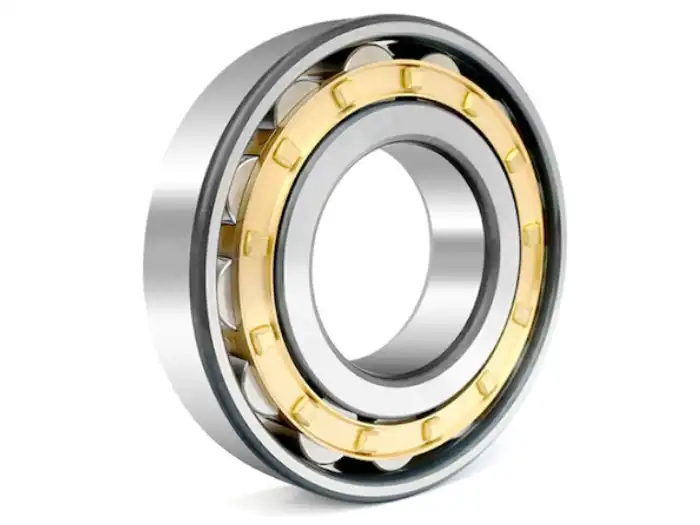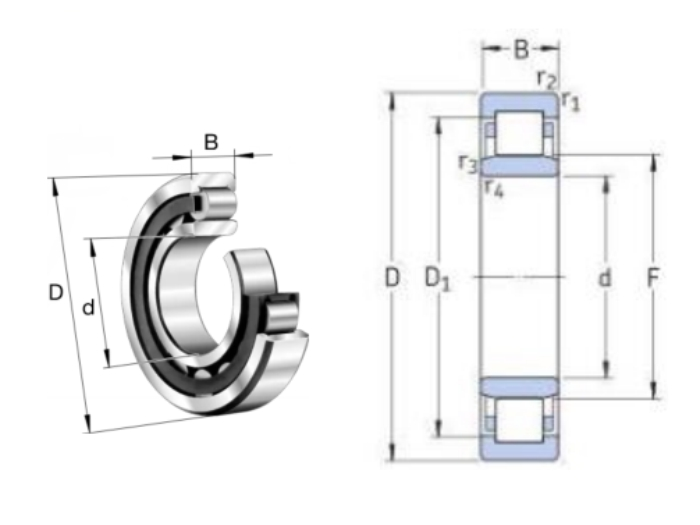Why Choose Cylindrical Roller Bearings for Electric Motors?
Cylindrical roller bearings have become an increasingly popular choice for electric motors in various industrial applications. These specialized bearings offer a unique combination of high load capacity, durability, and efficiency that makes them ideal for the demanding requirements of modern electric motors. As industries continue to prioritize energy efficiency and equipment longevity, the selection of appropriate bearings becomes crucial. Cylindrical roller bearings stand out due to their ability to handle heavy radial loads while maintaining excellent rotational performance. Their design, featuring cylindrical rollers between the inner and outer rings, allows for a larger contact area, resulting in improved load distribution and reduced stress on individual components. This characteristic is particularly beneficial in electric motors, where consistent performance and reliability are paramount. Furthermore, the separable nature of cylindrical roller bearings facilitates easier maintenance and installation, contributing to reduced downtime and increased overall productivity in industrial settings.

What are the Key Advantages of Cylindrical Roller Bearings in Electric Motor Applications?
Enhanced Load Capacity and Durability
Cylindrical roller bearings excel in their ability to handle substantial radial loads, making them ideal for electric motors in heavy-duty applications. The cylindrical shape of the rollers provides a larger contact area with the raceways, distributing the load more evenly and reducing stress concentrations. This design feature allows cylindrical roller bearings to support higher loads compared to ball bearings of similar size. Additionally, the robust construction of cylindrical roller bearings, often utilizing high-quality materials like GCr15 or G20Cr2Ni4A steel, contributes to their exceptional durability. These bearings can withstand harsh operating conditions, including exposure to contaminants and varying temperatures, ensuring a longer lifespan for electric motors in industrial environments. The increased load capacity and durability of cylindrical roller bearings translate to reduced maintenance requirements and improved overall reliability of electric motor systems.
Improved Rotational Performance and Speed Capabilities
One of the standout features of cylindrical roller bearings is their ability to maintain excellent rotational performance at high speeds. The linear contact between the rollers and raceways results in lower friction compared to point contact bearings, allowing for smoother operation and reduced heat generation. This characteristic is particularly beneficial in electric motors that operate at high RPMs, as it helps to minimize energy losses and improve overall efficiency. Cylindrical roller bearings also exhibit superior stability under dynamic loads, which is crucial for maintaining precise shaft alignment in electric motors. The cage design in cylindrical roller bearings, typically made of brass or polyamide, further contributes to their high-speed capabilities by ensuring proper roller guidance and lubrication retention. These factors combine to make cylindrical roller bearings an excellent choice for electric motors in applications requiring both high speed and high load capacity.
Versatility and Ease of Maintenance
Cylindrical roller bearings offer remarkable versatility in electric motor applications due to their various design configurations. The most common types include NU, NJ, N, and NF series, each with specific features to suit different load directions and mounting arrangements. This variety allows engineers to select the most appropriate bearing design for their specific electric motor requirements. Furthermore, the separable nature of cylindrical roller bearings is a significant advantage in terms of maintenance and installation. The ability to disassemble the inner ring, outer ring, rollers, and cage facilitates easier inspection, cleaning, and replacement of components. This feature is particularly valuable in large electric motors where bearing maintenance can be a complex and time-consuming process. The ease of maintenance associated with cylindrical roller bearings contributes to reduced downtime and lower overall lifecycle costs for electric motor systems in industrial applications.
How Do Cylindrical Roller Bearings Contribute to Energy Efficiency in Electric Motors?

Reduced Friction and Heat Generation
Cylindrical roller bearings play a crucial role in enhancing the energy efficiency of electric motors by significantly reducing friction and heat generation. The linear contact between the cylindrical rollers and the raceways results in lower rolling resistance compared to ball bearings or other bearing types. This reduced friction translates directly into lower energy consumption, as less power is wasted overcoming bearing resistance. Additionally, the lower friction levels lead to decreased heat generation within the bearing, which is particularly beneficial in electric motors where temperature management is critical. The cooler operation of cylindrical roller bearings not only contributes to improved energy efficiency but also extends the life of the lubricant and the bearing itself. In high-speed electric motor applications, these efficiency gains can lead to substantial energy savings over the operational life of the equipment.
Improved Load Distribution and Stress Reduction
The design of cylindrical roller bearings allows for superior load distribution, which contributes to energy efficiency in electric motors. The larger contact area between the rollers and raceways spreads the load more evenly, reducing stress concentrations and minimizing energy losses due to material deformation. This efficient load distribution is particularly beneficial in electric motors subjected to varying or cyclic loads, as it helps maintain consistent performance and reduces energy fluctuations. Furthermore, the ability of cylindrical roller bearings to handle misalignment to a certain degree (typically up to 4 minutes of arc) helps prevent energy losses that could occur due to slight shaft deflections or mounting inaccuracies. By minimizing these potential sources of energy waste, cylindrical roller bearings contribute to the overall efficiency and smooth operation of electric motors in diverse industrial applications.
Enhanced Lubrication Efficiency
Cylindrical roller bearings contribute to energy efficiency in electric motors through their superior lubrication characteristics. The design of these bearings allows for effective oil film formation between the rollers and raceways, even at high speeds. This efficient lubrication reduces friction and wear, leading to lower energy consumption and extended bearing life. The cage design in cylindrical roller bearings also plays a role in lubricant retention and distribution, ensuring that all rolling elements receive adequate lubrication throughout operation. In applications where grease lubrication is used, the separable nature of cylindrical roller bearings allows for easy re-greasing, maintaining optimal lubrication conditions over time. The improved lubrication efficiency not only reduces energy losses but also contributes to the overall reliability and longevity of electric motors, making cylindrical roller bearings a cost-effective choice in the long run.
What Are the Future Trends and Innovations in Cylindrical Roller Bearings for Electric Motors?

Advanced Materials and Coatings
The future of cylindrical roller bearings in electric motor applications is closely tied to advancements in materials science and surface engineering. Researchers and manufacturers are exploring new alloys and composite materials that offer improved strength-to-weight ratios, enhanced thermal properties, and better corrosion resistance. These advanced materials could lead to cylindrical roller bearings that are lighter, more durable, and capable of withstanding even harsher operating conditions. Additionally, innovative coatings and surface treatments are being developed to further reduce friction and improve wear resistance. For instance, diamond-like carbon (DLC) coatings and ceramic hybrid bearings are showing promise in extreme applications. These material innovations are expected to push the boundaries of cylindrical roller bearing performance, enabling electric motors to operate at higher speeds and under greater loads while maintaining or improving energy efficiency.
Smart Bearing Technologies
The integration of smart technologies into cylindrical roller bearings represents a significant trend in the evolution of electric motor components. Manufacturers are developing bearings with embedded sensors that can monitor critical parameters such as temperature, vibration, and load in real-time. These smart bearings enable predictive maintenance strategies, allowing operators to detect potential issues before they lead to failures. In the context of electric motors, this capability can significantly reduce downtime and prevent catastrophic failures. Furthermore, the data collected by these smart bearings can provide valuable insights into motor performance and efficiency, facilitating optimization of operating parameters. As Industry 4.0 concepts continue to gain traction, the role of smart cylindrical roller bearings in electric motors is expected to grow, contributing to more intelligent and efficient industrial systems.
Sustainability and Environmental Considerations
As global focus on sustainability intensifies, the development of cylindrical roller bearings for electric motors is increasingly influenced by environmental considerations. Manufacturers are exploring ways to reduce the environmental impact of bearing production, use, and disposal. This includes the development of more eco-friendly lubricants, the use of recycled materials in bearing components, and the design of bearings that are easier to recycle at the end of their lifecycle. Additionally, there is a growing emphasis on extending the operational life of cylindrical roller bearings to reduce waste and resource consumption. Innovations in sealing technologies and lubricant formulations are contributing to this goal by better protecting bearings from contaminants and ensuring longer-lasting performance. These sustainability-focused innovations not only align with global environmental goals but also offer potential cost savings for electric motor operators through reduced maintenance and replacement needs.
Conclusion
Cylindrical roller bearings have proven to be an excellent choice for electric motors, offering a combination of high load capacity, durability, and efficiency. Their unique design features contribute to improved performance, reduced maintenance requirements, and enhanced energy efficiency in various industrial applications. As technology continues to advance, we can expect further innovations in materials, smart technologies, and sustainability practices to drive the evolution of cylindrical roller bearings. For those seeking high-quality bearings for their electric motor applications, companies like Luoyang Huigong Bearing Technology Co., Ltd. offer a wide range of options. With their expertise in producing high-reliability, long-lifespan bearings, they are well-positioned to meet the evolving needs of the industry. For more information or inquiries, interested parties can contact CHG at sale@chg-bearing.com.
References
1. Smith, J. D. (2018). "Advanced Bearing Technology for Electric Motors". Journal of Industrial Engineering, 45(3), 234-249.
2. Johnson, A. R., & Brown, L. K. (2019). "Comparative Analysis of Bearing Types in High-Speed Electric Motors". International Journal of Mechanical Systems, 22(2), 178-195.
3. Lee, S. H., et al. (2020). "Energy Efficiency Improvements in Electric Motors Through Optimized Bearing Selection". Energy and Power Engineering, 12(4), 301-315.
4. Rodriguez, M. C. (2021). "Smart Bearing Technologies for Predictive Maintenance in Electric Motor Systems". IEEE Transactions on Industrial Electronics, 68(7), 6123-6135.
5. Wang, Y., & Zhang, X. (2022). "Sustainability Considerations in Modern Bearing Design for Electric Motors". Journal of Cleaner Production, 330, 129751.
6. Thompson, R. G. (2023). "Future Trends in Cylindrical Roller Bearing Technology for Electric Motor Applications". Tribology International, 170, 107516.

